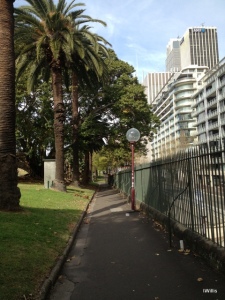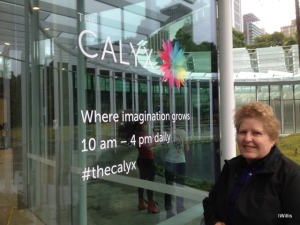The Domain and Royal Botanic Gardens are some of the most important open spaces and parkland in Australia’s urban places. The 29 hectares of gardens are surrounded by 51 hectares of parkland, including the Sydney Domain.
The gardens are traditionally divided into 4 sections: the Middle Garden, the Upper Garden, the Lower Garden and the Garden Palace Grounds.
They were officially recognised as a botanic garden in 1816, and while it only became the ‘Royal’ in 1959. The site is one of the world’s oldest colonial botanic gardens and one of the most important botanical sites in the Southern Hemisphere (only Rio de Janeiro is older).
The area attracts around 4 million visitors a year.
The Dictionary of Sydney states that the gardens reflect:
the changing styles of ‘public gardens’ – from the utilitarian beds that provided the necessities of life in the early years, to the emerging styles associated with new ideas about landscape gardening for visual effect, to the overwrought overkill of Victoriana, with statues, urns, terraces, ponds, plinths and obelisks at every turn, through to the contemporary acceptance of the validity of ‘native’ flora as a legitimate focus in a public garden.
The Botanic Gardens were the site of the first government farm in the colony of New South Wales in 1788 (Middle Garden) and called the Governor’s Farm in 1792. Governor Phillip ordered the cultivation of 20 acres in 1788, and the area was part of Governor Phillip’s private reserve.
The original farm furrows are evident in the alignment of the longitudinal beds of shrubs. The Governor’s Domain was one of the first pleasure grounds in the colony, established in 1792 by Governor Phillip.
There were some private land grants on the eastern side of Farm Cove (1800-1807), which were resumed under Governor Bligh when carriage roads were built around Bennelong Point and Farm Cove in 1807. The main botanic farm function was transferred to Rose Hill at this time under Governor King.
The Royal Botanic Gardens Trust states that in 1810
The new Governor, Lachlan Macquarie, terminate[d] leases and embarks on wall and fence building to re-establish the Domain as the Governor’s private parkland. His walls and rules [were] flouted.
The gardens link the oldest surviving group of Governor Macquarie period buildings in Australia along Macquarie Street (1810).
Governor Macquarie also landscaped the domain with a gate and sandstone wall. The wall, which now separates the Lower and Middle Garden, was built between 1812 and 1816 to protect the garden from the harbour. In Governor Macquarie’s time (1816),
Mrs Macquarie Road was completed around the Domain to Mrs Macquarie Point.
The work of the gardens illustrates the associations with the 18th century European scientific world of Sir Joseph Banks, Sir William Hooker and others. The gardens are Australia’s oldest scientific institution (1816) for botany and horticulture. In 1821, Superintendent Charles Fraser, a botanist, was appointed to develop the gardens along scientific grounds for the first time. Fraser accompanied John Oxley on his inland journeys and brought back plant specimens.
In 1825, Governor Brisbane extended the garden west of Farm Cove for an experimental garden to acclimatise Australian plants for export and imported plants. Colonists were interested in ‘exotics’ and brought many of them with them and were added to the garden plant collection. In 1829, grape vines were planted, which became important in the foundation of the Australian wine industry.
1831 Governor Bourke opened roads and paths for general access despite conservative opposition.
By the 1850s, military, sporting, and ceremonial events had become common in the domain. The area was the home of first-class cricket in New South Wales from 1857 to 1871, and the first interstate match was held in the Domain in 1851 when NSW defeated Victoria.
There were the first swimming championships in 1846 and a gymnasium (public playground).
Construction commenced for the new government house in the northern section of the Domain in 1837. It was completed in 1845. The area was the site of Australia’s first zoo, an aviary in 1860 that was expanded into a larger facility with a monkey house in 1880. Eventually, the zoo was relocated to Moore Park in 1883.
The Domain and gardens were the site of the 1878 International Exhibition, and the Garden Palace (1879), which burnt down in a spectacular fire in 1882, was the first exhibition in Australia featuring arts and industrial displays.
The Garden Palace was located between the Conservatorium of Music (formerly the Government House Stables) and Macquarie Street. The site is the highest point in the garden and was originally surrounded by a paling fence for grazing the governor’s stock.
The Central Depot in the gardens was the kitchen garden for the government house (Bridge Street, then Macquarie Street) from 1813 to 1870, and it still has a rare glasshouse.
The northern boundary of the garden is the sandstone wall adjacent to the Opera House, which has stone steps and iron railing.
The cliff wall, built in 1880, enabled the extension of Macquarie Street and is known as the Tarpeian Way. It provides a dramatic backdrop to the Opera House forecourt and gets its name from the famous rock on Capitoline Hill in Rome, where prisoners were hurled to their deaths in ancient times.
What are now the Opera House iron gates were originally the Governor’s private gates and were built-in 1870.
The Lower Garden was reclaimed from Farm Cove between 1848 and 1879 when the seawall was constructed with stone from the old government house on Bridge Street. This work extended the garden’s pleasure grounds with curving pleasure walks and plantings.
In the Domain, the Hospital Road gate lodge and gate were built around 1865, and the Victorian gate lodge house was built on the eastern side of the garden. The Victorian herbarium building was constructed in 1899 and adapted as the visitor centre in 1982.
The Domain was quite extensive at one stage, and successive governments have taken bits of it for various cultural institutions -the Art Gallery of New South Wales (1885+), the State Library of NSW (1910+), Government House (1836+), Opera House (1966+), and Conservatorium of Music (formerly Government House Stables, 1816 and CoM, 1916+) -and oil tanks for the Navy in WW2.
The Domain has been a site of decent by the Sydney populace. The Dictionary of Sydney states:
The Domain has also had an important history as a ‘soap box’ arena, like London’s Speakers’ Corner in Hyde Park. ‘Soapbox Sunday’ may well go back into the late nineteenth century: in 1878, Baptist pastor Allen is reported to have gone there to speak on Irish Home Rule, after a riot in nearby Hyde Park. The Domain has been the site of free opera events as part of the Sydney Festival since 1982.
The gardens and domain have suffered under the influence of modernism. In the 1920s, the site was dug up using a cut-and-cover construction method to build the City Loop of the underground railway on the western side of the Domain.
In 1956, the City of Sydney took the western side of the Domain and constructed a car park, resulting in the loss of 47 rare trees. The influence of the car again played out with the construction of the Cahill Expressway between 1958 and the 1960s, which resulted in the loss of the Fig Tree Avenue planted in 1847 and the division of the gardens and the domain areas.
In 1978, the administration of the gardens and Domain was transferred from the Department of Agriculture (from 1908) to the Premier’s Department.
In 1980, the state government passed the Royal Botanic Gardens Trust Act to secure the extent of the grounds, and the administration of Centennial Park administration became autonomous. The Friends of the Botanic Garden was established in 1982.
Development of the gardens and Domain occurred in 1970 and 1971 with the construction of The Pyramid as a tropical glasshouse. Two annexes were established in 1988 at Mount Annan (native plantings) and Mount Tomah (cool-climate plantings), and in 2016, in the Upper Garden, the new Calyx replaced the demolished Pyramid as the tropical plant centre.
To read more, go to the Royal Botanic Gardens’ website and read about the gardens’ history and heritage at the State Heritage Inventory.
The Dictionary of Sydney has some interesting stories about the Domain and the Royal Botanic Gardens, and the Domain is one of the most popular spots for the Sydney Festival.
Updated 27 April 2024. Originally posted on 26 January 2017.

















You must be logged in to post a comment.